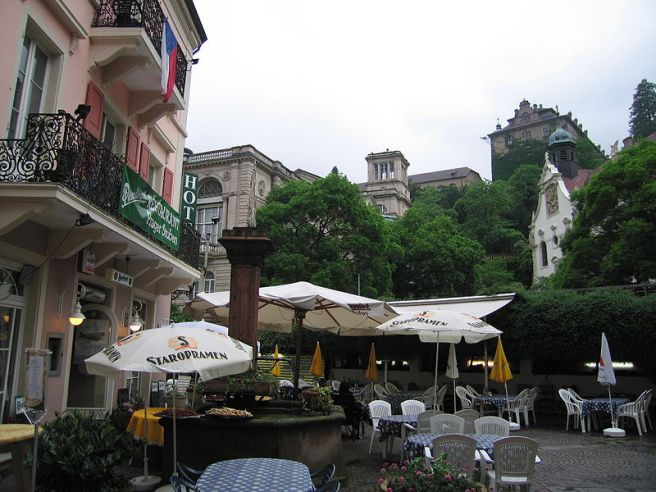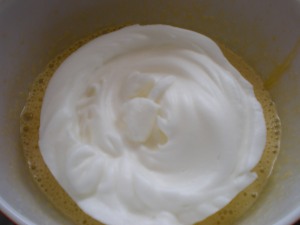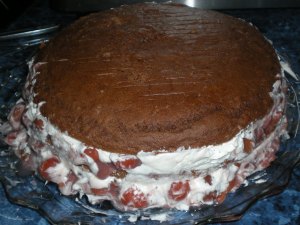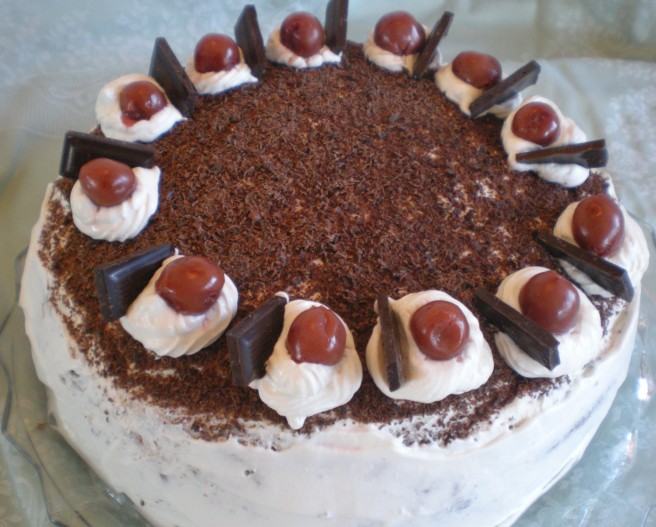This post took a while to create and takes you to the final destination of our gluten free Black Forest Torte recipe via some travel scenes through the beautiful and enchanting Black forest. Schwarzwälder Kirschtorte (Black Forest Cake/Gateau) is well-known in many parts of the world, although very few have had the privilege of tasting and experiencing the original recipe. It is a special dessert, usually reserved for special occasions. Any Konditorei (pastry shop) will offer it, if not on a regular basis, with relative frequency, due to its popularity, and each one usually manages to give it a unique touch, while claiming that it is based on the original recipe.
Residents of the Black Forest region claim that the original history and creation of the Schwarzwälder Kirschtorte originates somewhere within the hills and valleys of this part of Southwest Germany. It is speculated that the ‘torte’ bears a similarity to the native costumes of the region. The “Bollenhut” (hat with giant red pompoms)
reminding one of the red sour cherries (morello), the cream of the white blouse, and the dark chocolate of the black dress.
Historians date the inception of the cake back to the 16th Century, when chocolate was first introduced to Western Europe and used in cakes and cookies. In 1934, the Schwarzwälder Kirschtorte was first mentioned in a published format in a book by J.M. Erich Weber, Dresden, 1934, called “250 Konditorei-Spezialitäten und Wie Sie Entstehen,” and by 1949, this specialty cake was attributed the 13th place in a list of the most popular and well-known tortes of Germany. From then on it began to rise in popularity and is now renowned all over the world.
Cafe and Konditorei Schäfer, holds the original recipe and claims to be the birthplace of the Schwarzwälder Kirschtorte. You can check out their website for additional information. This dessert is also known as Black Forest Gateau, and usually consists of multiple layers of a chocolate sponge cake, cherries and whipped cream, and is frosted with additional whipped cream, topped with chocolate shavings and additional cherries. Kirschwasser (cherry brandy or Schnaps) is used to flavor the cherries and/or the whipped cream, although some drizzle it lightly on the first and/or second layer of sponge cake as well.
These pictures are just two examples of some of the variations you might find in your typical pastry shop, or in someone’s home.
Kirschwasser typically has an alcohol content of 80-100 proof (40-50%ABV) and it takes approximately 10 kg (22 pounds) of cherries to make one 750 ml bottle of Kirsch. It is served as an apéritif in a small glass, and in the German speaking areas, is also served as a digestive after dinner. In addition, Kirsch is also used as an essential ingredient in a Swiss cheese fondue and the classic Gugelhupf cake. Additional information is available here.
The traditional cherries used for this cake are the Morello cherries which grow in the Schwarzwald (Black Forest).
Just mentioning the name of the region “Black Forest” for which this cake is named, for most visitors and tourists, conjures up images of cuckoo clocks, Kirsch (cherry schnaps), Black Forest Cake, and the typical houses in this part of the world.
Yet, to locals and visitors alike, it is a favorite vacation destination, offering beautiful places for hiking, skiing, relaxation and renewal. Naturally its world renowned spas offer the perfect relief from today’s hectic and stressful lives.
The Black Forest (German: Schwarzwald) is a heavily wooded and mountainous region in Southwestern Germany, in the State of Baden-Württemberg.
To the South and West it is bordered by the Rhine. The Feldberg with an elevation of 1,493 meters (4,898 ft), is its highest peak. On the Western edge of the Black Forest, the cities of Freiburg and Baden-Baden are well-known and popular destinations. Some of the towns located within the forest include Bad Herrenalb, Baiersbronn, Calw (which is the birth place of Hermann Hesse),
Freudenstadt, Furtwangen, Gengenbach, Schramberg, Staufen, Titisee-Neustadt, Hausach and Wolfach. The most visited destinations include the Feldberg, Titisee, Schluchsee and the Triberg Waterfalls.
A long time ago, this region was renowned for its dense and seemingly impenetrable pine and fir forests. Sadly, like so many other beautiful forests in the world, this region has been damaged by mass logging over many years, as well as the destruction left behind by storm “Lothar” back in 1999. Today, the local forestry industry is trying to maintain a managed approach between regrowing diseased and clearcut areas and harvesting trees for the wood industry, but we may never see the old forests again. In fact, the actual forest is only a fraction of its original size.
Next to wood, silver and gold have also been sizeable industries. When the wood trade began to falter, the clock making industry was birthed and has been a very successful industry since the 17th century. The German clock museum (Deutsches Uhrenmuseum) is located in Furtwangen and houses a broad collection of clocks and other local artifacts. You can learn more about this museum here.
As already mentioned earlier, any visitor to the area also remembers the traditional costumes of the past, especially the Bollenhüte (hats with enormous red pompoms). Today, the ‘Trachten‘ (native costumes) are only worn in certain areas of the Black Forest and are reserved for special occasions only.
Mythologically, the Black Forest region is rich with stories of werewolves, sorcerers and witches, but also filled with tales about little benevolent and helpful dwarves.
The city of Baden-Baden is generally thought of as the gateway to the Black Forest, situated near the Autobahn 5, not far from Strasbourg, France.
It is best known for its spas and therapeutic bathhouses.
In 1931, the town of Baden-Baden was officially given its double name, which actually stands for “Baden in Baden” (Baden in the State of Baden-Württemberg). Former President Bill Clinton was so taken by this beautiful town that he said “Baden-Baden is so nice, they had to name it twice.” This town escaped destruction during both world wars and after World War II, became the headquarters of the French forces in Germany. Its airport is located just 15 km west of town, CFB Baden-Söllingen, and is Baden-Württemberg’s second largest airport.
Baden-Baden is well-known for its casino and the Kurhaus
The Festspielhaus Baden-Baden (Festival Theatre of Baden-Baden) is Germany’s largest opera house and concert hall, seating 2,500 people. You can learn more about the Festspielhaus here.
Other attractions include, the Old Castle “Hohenbaden,” built in 1102, a ruin since the 15th century, and the New Castle (Neues Schloss), which is the former residence of the margraves of Baden, and later of the grand dukes of Baden. It is now home to the historical museum.
Ruins of Roman baths, about 2,000 years old were rediscovered and excavated in 1847.
The Stiftskirche houses the tombs of 14 margraves of Baden.
Another notable attraction is the Merkurbergbahn which is a funicular railway and climbs Mount Merkur.
For some film footage on Baden-Baden you can visit this site and discover further information here.
The Merkurbergbahn was originally opened in 1913 (closed in the late 60’s), and reopened back in 1979. Its two cars can accommodate up to 30 passengers per car and travel to a height of 370 meters, traversing a maximum level of steepness of 54%.
The Springs of Baden-Baden have been well-known for over 2,000 years and resemble the Roman baths of the 3rd century. The “Caracalla-Therme” spa is rich in sodium chloride and comes from artesian wells some 1,800 meters below the Florentiner Mountain. These Springs have been sought out by many, especially royalty and the rich and famous. Over 150 years ago, the top of Russian society sought out the therapeutic waters in Baden-Baden. Even today, you can hear Russian spoken in this beautiful town.
Nearer the center of the Black Forest is the town of Triberg, home of Germany’s largest waterfall (163 m), a popular vacation destination, as well as its cuckoo clocks and the Schwarzwälder Kirschtorte, and the 1,600 square meter Schwarzwaldmuseum.
The most famous and well-travelled route is B500, also known as the Black Forest High Street (Schwarzwaldhochstrasse), which extends from Baden-Baden to Freudenstadt and welcomes you with some of the most beautiful scenery, forests and valleys. The Mummelsee is a major resort destination near the highest point on the High Street. A wonderful website, describing travels throughout this region can be found here.
The river Neckar rises in the Black Forest near Villingen-Schwenningen at the height of 706 m above sea level, and then passes through Rottweil, Rottenburg am Neckar, Kilchberg, Tübingen, Nürtingen, Plochingen, Esslingen, Stuttgart, Ludwigsburg, Marbach, Heilbronn and Heidelberg, before it finally discharges into the Rhine river at Mannheim, at 95 m above sea level. We visited the locks along the Neckar river, near Stuttgart, many times in my childhood and I have many fond memories of those trips.
The name Neckar was derived from Nicarus and Neccarus from the Celtic Nikros, meaning wild water, or wild fellow. Dating back to around 1100, wood from the Black Forest was transported by timber rafting, for use in shipyards in Holland. After 1899, rafting was limited to the lower part of the Neckar. Many locks were completed along the Neckar, the last of 27 was completed in 1968, making it possible for cargo ships to navigate the Neckar.
The Black Forest has much to offer and we cannot possibly do it justice in this one post. Please check out the links provided and learn a little bit more about it.
Now, at last, to our latest endeavour,
Gluten Free Schwarzwälder Kirschtorte (Black Forest Gateau):
This cake is a little bit more involved than some, in the sense that it takes a little extra time. It is also a little richer and just so much more exquisite than most, that is why it is usually reserved for special occasions. Remember, the number one ingredient in any recipe is always LOVE, which also makes the following steps a lot easier to follow. You will hardly believe that this cake is gluten free, because it tastes so good and just like regular wheat fare. Both types of dough are very easy to work with and always turn out rather well!
Just be sure to read the entire recipe ahead of time, since each part of this cake is being described separately and some refrigeration is required along the way.
Black Forest Torte:
Ingredients for the first bottom layer:
- 1/2 cup (75g) brown rice flour
- 1/2 cup (75g) sorghum flour
- 1/2 tsp. guar gum, or 1 tsp. xanthan gum
- 1 level Tbsp. (10g) cacao
- 1 level tsp. baking powder
- 2 heaping Tbsp. (50g) sucanat
- 1 tsp. vanilla extract
- 1 egg
- 1 Tbsp. water
- 1/2 stick (50g) cold butter, cut into small pieces
- a little extra butter for greasing the pan
- parchment paper
- 9-inch Spring form baking pan
Preheat the oven to 375°F/200-220°C.
On a baking board, mix the flour, cacao and baking powder. Make an indent in the middle and add the sucanat, vanilla extract, egg and water. Mix until a crumbly dough is formed. Place the cold butter pieces on top and work everything quickly into a smooth dough. If the dough remains a little sticky, place it covered into the refrigerator for about 20-30 minutes.
Grease the spring form pan with a little butter and line it with parchment paper, covering only the bottom not the sides (trace the outline of the Springform on the parchment paper and cut out – you want to cut out two pieces, as you will need the second one for the sponge cake). Grease the parchment paper just slightly as well. Roll out the dough (sprinkle a little extra rice flour on your board beforehand) and place it in the prepared Spring form, carefully cutting the dough, so only the bottom of the pan is covered (you can use up any extra dough by cutting it our with your favorite cookie cutter, for an extra treat).
Bake for about 30 minutes, remove from oven, release the Spring form pan, invert onto a cooling rack and peel off the parchment paper. Let cool completely.
Sponge cake (Biskuitboden) ingredients:
All ingredients need to be at room temperature!
- 4 egg yolks
- 4 egg whites
- 6 Tbsps. room temperature water
- 3/4 cup sucanat
- 2 tsp. vanilla extract
- 1/8 tsp. ground cinnamon
- 1 cup (140g) tapioca flour
- 1/2 cup (75g) brown rice flour
- 1/2 cup (75g) chestnut flour
- 3/4 tsp. guar gum, or 1-1/2 tsp. xanthan gum
- 1/4 cup cacao powder
- 2 tsp. baking powder
- small amount of butter for greasing pan
- 9-inch Spring form pan
- parchment paper
Grease the bottom of the Spring form only (!) and line with the extra parchment paper you cut out during the first step of this recipe. Again slightly grease the parchment paper as well, but be very careful that no grease gets on the outer Spring form ring, because it will prevent the Sponge cake from rising properly.
Preheat the oven to 350°F/180°C.
For this next step, you will need two bowls, a smaller one for whipping the egg whites, and a larger one for the preparation of the batter.
Separate the 4 eggs (yolks into the larger bowl, egg whites in the other). With a hand mixer, whip the egg whites until they form glossy and shiny peaks. Set aside.
In the other bowl, combine the egg yolks with water and blend well, using the hand mixer. Little by little, add the sucanat and vanilla extract. Continue to mix until the batter becomes smooth and creamy.
Put away the hand mixer, as it will not be needed for the final step. Place the whipped egg whites on top of the yolk batter, and set aside for a moment.
Place the flour blend, guar gum, cacao and baking powder into a sifter (you can also use a fine sieve) and gently sift the ingredients on top of the egg whites.
Now, carefully fold the flour and egg white into the batter. You want to take your time with this step. You are not looking to stir, or mix, but truly just slowly fold the ingredients together. This is best done with a rubber spatula, or a large spoon.
When the flour has been fully incorporated into the batter, it should still retain its light and airy texture. Pour this batter into the prepared Spring form and smooth and level out the top, using a spatula.
Bake in the preheated oven for 25 minutes (The baking duration depends on many factors: your own location, elevation, temperature, etc. and will play a role in how long this will take – usually anywhere from 20-30 minutes. We are at 6,800 ft. and it is consistently done at 25 minutes).
Remove the cake from the oven, release it from the Spring form, turn out onto a wire rack to cool and peel off the parchment paper.
Once completely cooled, slice the sponge cake horizontally into 3 thin layers. Place each layer on a separate plate.
Ingredients for the Filling and Topping:
- 750 g fresh sour cherries, or 1-3/4 cans sour cherries, or equivalent amount of frozen cherries, which have been completely defrosted (we used canned, for lack of other options)
- 1/2 cup (75g) sucanat
- 4 Tbsp. arrowroot flour
- 2 Tbsp. Kirchwasser, or brandy
- 2 packets gelatine powder (you will need one for the cherries, and one for the whipped cream. Each packet needs to be dissolved with 3 Tbsp. water before adding to the recipe.)
- 2 cups (1/2 L, or 16oz.) organic whipping cream
- 2 tsp. vanilla extract
- 1 Tbsp.organic powdered sugar, sifted
- 3 Tbsp. (30g) grated dark gluten free Trader Joe’s chocolate
- 1 bar Dark Gluten Free Trader Joe’s chocolate, broken into 12 individual pieces, for decoration.
If fresh cherries are available, wash them and remove the stones. Mix the cherries with a little sucanat. Set this aside for at least 20 minutes to draw out the juice. Then cook them briefly in their own juice. Remove and drain the juice into a separate bowl, preserving the juice. If you are using canned, drain the juice into a separate container. Set aside about 12 cherries for decorating the top of the cake. You will need 1/4 L (1 cup) of the cherry juice (top off with enough water, if there is not enough juice). Remove 4 Tbsp. of this juice and place in a separate bowl, mixing it with the arrowroot flour. In a saucepan, heat the cherry juice, bring it to a boil, remove and add the blended arrowroot/cherry juice liquid. Mix one packet of the gelatine with 3 Tbsp. of water, making sure it is completely dissolved, and add this to the boiled cherry juice. Bring everything back to a brief boil and then remove from heat, adding the cherries, remaining sucanat and Kirschwasser. Set aside and let cool.
Prepare the second gelatine packet by mixing it with 3 Tbsp. of water, allowing it to dissolve completely. Set aside. Add the whipping cream to a larger mixing bowl, and with a hand mixer, whip until firm, then add the sifted powdered sugar and the prepared gelatine. Continue to whip until nice and firm.
Assembly of Cake:
Select a cake plate of your choice and place the first baked bottom layer on it. Add half the amount of the cherry blend to this layer, topping that with a thin layer of whipped cream.
Then add the first sponge cake layer on top of this.
Top this layer with the remaining cherry filling and a thin layer of whipped cream. Spread out evenly and top with the second sponge cake layer.
Add another thin layer of whipped cream to this and place the final Sponge cake layer on top.
Spread just a smooth layer of whipped cream on the final layer, setting some whipped cream aside for the final steps. Now for this next step, you need to cut out large enough strips of parchment paper to drape around the outside of the cake, which helps to retain the filling. If you have one available, use just the outer rim of another, slightly larger, Spring form pan and place it on the outside of the draped parchment paper, and close the spring. This ensures the even setting of the filling. Place the cake in the refrigerator for a couple of hours to set the filling.
Meanwhile, grate the chocolate and set aside.
Remove the cake from the refrigerator and take off the Spring form ring, and carefully peel off the parchment paper. Remove any excess filling that was not contained by the paper, or outer ring, and then spread some additional whipped cream on the outer rim of the cake. Sprinkle the top with the grated chocolate. Place the remaining whipped cream in a pastry bag, fitted with a small rosette tip, and place 12 rosettes evenly spaced on top of the cake. Place one cherry (which you reserved earlier) on top of each rosette, and, if desired, a small piece of chocolate next to each rosette.
Finally, relax, brew yourself your favorite tea, or coffee, and enjoy a slice.
Where I grew up, this dessert, was served only on special occasions such as special birthday celebrations, anniversaries and weddings and obviously more often during cherry season than any other. Since so many in the gluten free and celiac communities forego making some of these recipes, or rely too strongly on just prepared mixes, I wanted to experiment and bake this, in order for many more to enjoy this in a gluten free version. Enjoy!!! Let me know how your version turns out.
Inge
Ed. Update: 10/8/13 Updated photos coming soon.




















































Fantastic post! I learned so much! Thank you for sharing so much history about the Black Forest Cake!
what a fabulous cake and amazing site with such photos and details. Thank you again.
Sandy
Sandy,
Thanks for the lovely comment. Black Forest Torte seems to be everybody’s favorite.
Great site! I’m a teacher who was researching the Black Forest ( couldn’t resist having a look at THE cake) and my Mum is a Ceoliac, so I’ll be looking at your site more often.
Nice to meet you and look forward to hearing from you again. Let us know how the Black Forest Torte turns out for you. Hope the research is going well. 🙂
AND THE SECRET IS ——————– MAKE SURE ALL YOUR INGREDIENTS are at ROOM temperature!
Linda
http://coloradofarmlife.wordpress.com
http://deltacountyhistoricalsociety.wordpress.com
I gave up sugar and desserts on my quest for vitality and health, but your post is so thorough with historic and regional details. I met a man from the Black Forest region when I was 22 years old–a long time ago, but your post reminded me of him.
Hi Patricia, despite outer appearances running a food blog, we don’t indulge in desserts either, consume no white sugar whatsoever, and keep even healthier options to a minimum. The post about the Black Forest region was so much fun to write and we are happy that it brought back fun memories for you.